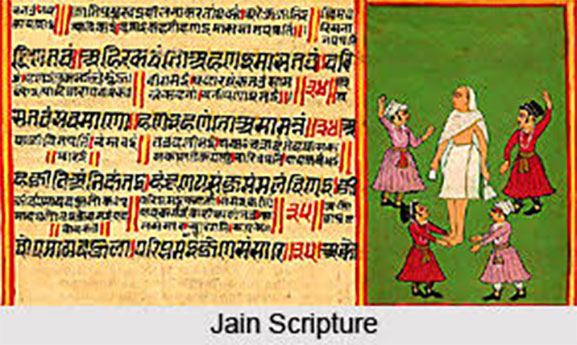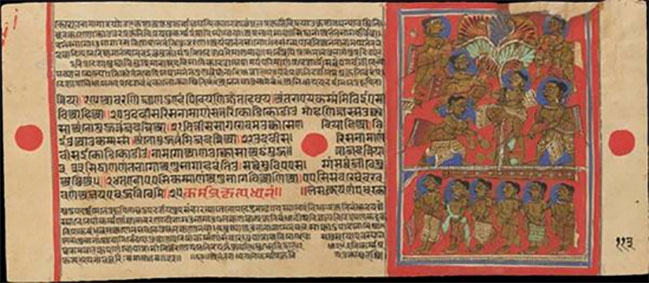Jainavenue is a medium to serve the spiritual path of Jainism


Whatever may be the case, Prakrit holds an important position in ancient Indian languages and its contribution to Indian literature cannot be ignored. The word Prakrit has been derived from two root words “Prak” meaning before and “Krit” meaning created i.e. something that was created or existed from beforehand or something that exists since long. Prakriti also means something that is natural. In other words, the language that was used for communication by masses and naturally evolved without being bound by any grammar rules is Prakrit. In contemporary world, it is called Lingua Franca i.e. Lok Bhasa or Boli.
There are multiple schools of thought regarding origination and evolution of Prakrit as a Language. Few scholars believe that Prakrit (which is a raw form of a language) has been originated from Sanskrit (which is a refined form) whereas few others believe that Sanskrit has been evolved from Prakrit. Yet there is another set of scholars which believe that they are Sahodara i.e. existed and developed alongside influencing each other.
In 6 BCE when Tirthankar Mahavir was born in Magadh, Ardhmagdhi/Magdhi was the Prakrit dialect that was used for communication among commoners. He gave his discourses in Ardhmagdhi, so that it can reach easily to all levels of people in the society. His disciples continued the tradition and compiled his teachings in 46 Prakrit texts which is known as Aagam Sahitya. As per Digambar tradition Aagam literature was lost. Acarya Dharsen taught Muni Bhutbali and Pushpadanta parts of Purvas of Drstivad (one of the Anga Aagam) and Vivaha Pannati. Later Digambar Aagam equivalent texts like Shatkhandagam was created based on this knowledge. Shatkhandagam is written in Saurseni Prakrit (Dialect of Gujarat and Rajasthan region).
Aagams are written in Sutra form where there are few words but deep meanings. Many times, even a single sentence or word can be interpreted in many ways. They also contain a lot of Jaina religion specific terminology. Just by reading them, one may not be able to understand multiple meanings embedded within. Thus, facilitate the understanding of Aagams, a vast body of commentaries known as ‘Vyakhya Sahitya’ have been written by Acaryas. Vyakhya Sahitya can be categorized in four main parts called Niryukti, Bhasya, Churni and Tika. There is an equally big commentary literature available based on Digambar Aagma equivalent texts. These commentaries provide valuable insights into the meaning and significance of the Agamas, as well as guidance on how to apply their teachings in everyday life
In addition to this, Jaina Acaryas and Scholars have contributed many independent texts in Prakrit on varied topics like Jaina metaphysics, ethics, rituals, spiritual lineage, logic, historical essays, places of pilgrimage, code of conduct of Ascetics, code of conduct of householder etc. Order of Acaryas depicted in Spiritual linage texts are historically significant. Essays assist in study of Indian History and various Prakrit dialects.
Stories and examples help transmit values and shape minds easily and interestingly. There are many such novels, stories, short stories, narratives and biographies in Prakrit written by Jaina Acaryas so that difficult concepts can be comprehended easily by varied audience. For e.g. Samraichhakaha is a novel that depicts nine births of hero Samraditya and Villain Agnisharma. Vasudev Hindi is a travel log of Krishna’s father Vasudev. Dhurtakyan is sarcastic humour. The list is endless. Acaryas have written biographies which includes the life stories of Tirthankars, Chakravarties, Vasudevs, Acaryas, great man and women. Paumachariyam is one such biography which illustrates story of Ram.
The knowledge of Prakrit would enable scholars and practitioners with access to this vast body of philosophical and religious works of Jaina religion and would facilitate deeper understanding and comprehension of various principles and concepts of the same. It will allow them to engage more deeply with the original teachings, doctrines and scriptures of Jain tradition.
As stated by Dr. Jagdishchandra Jain in “Prakrit Sahitya ka Itihass”, Aagam and its vast Commentary literature together illustrates many legends, traditions, values, distinguishing discussions, historic, half historic and mythological beliefs, and religious and folk stories as well as narratives that are related to Jaina Dharma, since ancient times. What is available here is not available in Buddhist and Hindu texts and hence this knowledge is even important from the perspective of development of literature and language
Photo: 2nd C.E. to 1 A.D. Hatigupha Inscription

Many Ashokan rock edicts are found all over India as well as in neighbouring countries like Bangladesh, Afghanistan and Pakistan and Nepal. They are written in Brahmi script and Pali. Seventeen-line Prakrit inscription found in Hathigupha cave on Udaygiri Hills near Bhuvneshawar, dated between the second century BCE and the first century CE, is about Jaina king Kharvel. Many other such Prakrit inscriptions are found in India. Knowledge of Prakrit is necessary to conduct research, analyse texts and interpreting such historical artefacts.
Prakrit has a long journey of development over more than 2000 years. It was language of communication across large land masses and among diverse communities in ancient India resulting in many dialects such as Magadhi, Ardhmaghadhi, Saurseni, Pali, Maharastri, etc. Gautam Buddha, contemporary of Mahavir, also chose to spread his message through the medium of Prakrit. Tripithak consists of his compiled discourses. The form of Prakrit used in Tripithak is known as Pali.
Prakrit literature also encompasses rich array of genres, including poetry, Drama, prose and Grammar texts by non-Jain writers too. These texts often reflect the vernacular expressions, idioms and dialectical variations prevalent during different historical periods. Gahasaptasati is considered as the best text of Prakrit poetry written in Maharastri Prakrit. Like Gahasaptasati, Vajjalagam is also a collection of poems compiled by Jaina scholar Jagvallabh. In Sanskrit dramas, characters that are not elite shown to deliver their dialogues in various dialects of Prakrit.

Manuscripts are handwritten texts of past when printing was yet not developed. Many religious and government manuscript libraries contain Prakrit manuscripts which are yet to be deciphered.
Study Prakrit literature and its dialects provides a peek into the History. Scholars can gain insights into the art, culture, social history, geographic and linguistic diversity of ancient Indian societies. It enables readers to appreciate the artistic and literary achievements of ancient Indian writers and poets, who expressed a wide range of human experiences, emotions, and insights through their works.
Proficiency in Prakrit is essential for scholars and researchers specialising in fields such as South Asian studies, Indology, comparative literature, linguistic and religious studies. Knowledge of Prakrit opens opportunities for academic research, textual analysis and interdisciplinary exploration of Indian culture and civilization.
Ancient languages often provide direct access to the thoughts, beliefs and values of ancient civilization. Prakrit is such a jewel that has capacity to brighten the unexplored and unrevealed mysteries of Jaina philosophy in particular and Indian culture in general.


My brother suggested I might like this blog He was totally right This post actually made my day You can not imagine simply how much time I had spent for this info Thanks
Hi my family member I want to say that this post is awesome nice written and come with approximately all significant infos I would like to peer extra posts like this
I have read some excellent stuff here Definitely value bookmarking for revisiting I wonder how much effort you put to make the sort of excellent informative website
Hi my loved one I wish to say that this post is amazing nice written and include approximately all vital infos Id like to peer more posts like this
nice linking to history study but you could make it more impressive some of us may even remember it for a life time